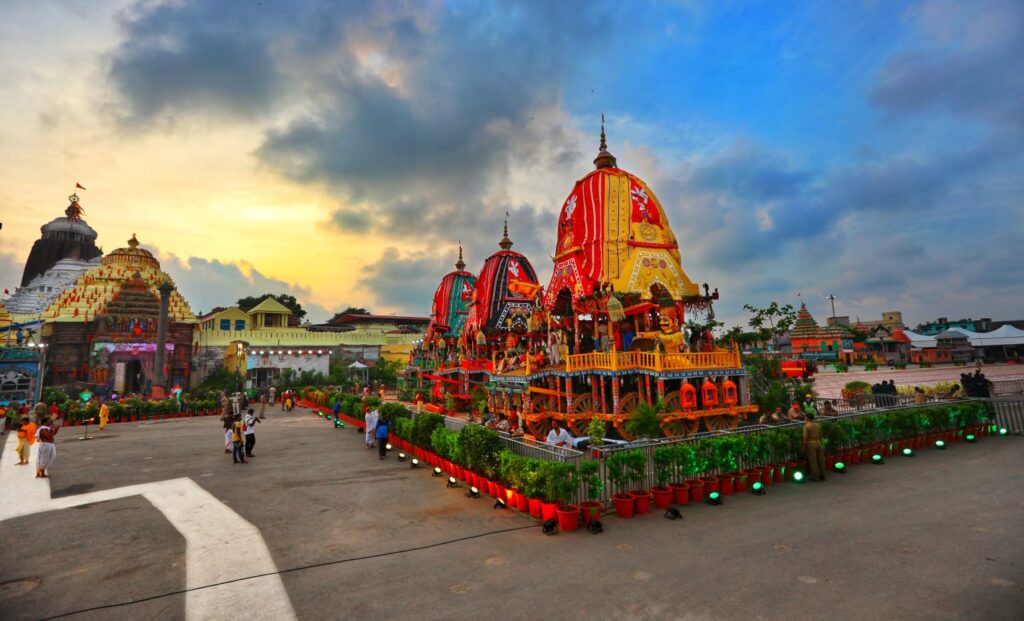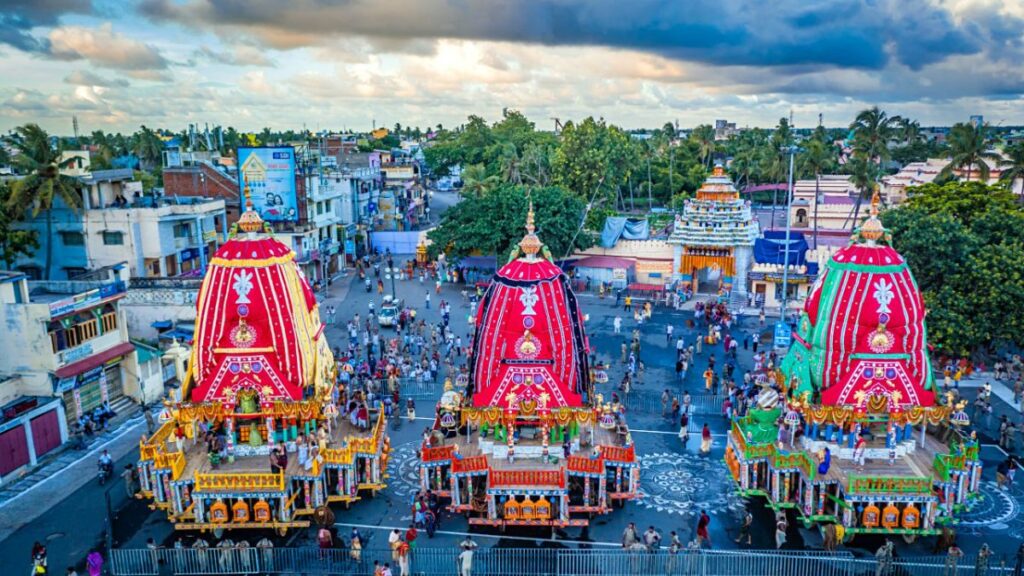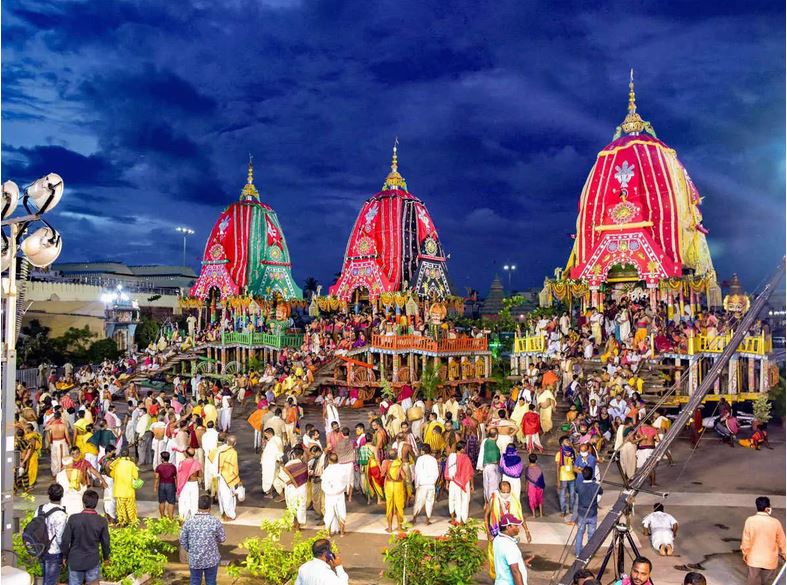Ratha Jatra, also known as the Chariot Festival, is a magnificent and eagerly awaited celebration in the state of Odisha, India. This grand festival honors Lord Jagannath, the presiding deity of the famous Jagannath Temple in Puri. Ratha Jatra holds immense religious significance and attracts millions of devotees from all corners of the country.

The origins of Ratha Jatra can be traced back to ancient scriptures and legends. According to mythology, Lord Jagannath, along with his siblings – Goddess Subhadra and Lord Balabhadra – embarks on a divine journey from the Jagannath Temple to the Gundicha Temple, located about three kilometers away. This symbolic journey represents Lord Jagannath’s annual visit to his aunt’s house.
Ratha Jatra takes place during the Hindu month of Ashadha (June-July) and lasts for nine days. The festival commences with the ritual of “Pahandi,” where the deities are ceremoniously brought out of the temple and placed on elaborately decorated chariots. These majestic chariots, known as “Raths,” are constructed anew every year with specific types of wood.
The three chariots used in Ratha Jatra are named Nandighosa (for Lord Jagannath), Taladhwaja (for Lord Balabhadra), and Darpadalana (for Goddess Subhadra). Each chariot is distinct in size, structure, and color, reflecting the divine personalities of the deities they carry.
You can read our another post on International Friendship Day

On the day of Ratha Jatra, the chariots are pulled by thousands of devotees through the streets of Puri amidst great enthusiasm and devotion. The pulling of the chariots is considered immensely auspicious, as it is believed to earn the devotees blessings and spiritual merit. The rhythmic chants of “Jai Jagannath!” fill the air, creating an atmosphere charged with devotion and joy.
The chariot procession covers a distance of about three kilometers, culminating at the Gundicha Temple. The journey, known as the “Bahuda Yatra,” takes place on the ninth day of Ratha Jatra. It symbolizes the return journey of Lord Jagannath, Goddess Subhadra, and Lord Balabhadra to their abode at the Jagannath Temple.
During Ratha Jatra, the streets of Puri come alive with vibrant colors, music, dance, and cultural performances. Devotees from different communities adorn traditional attire and participate in processions, carrying flags, banners, and religious symbols. The entire city resonates with the devotional fervor and festive spirit.
More: Wanted to download Odishashop.com visit here

One of the most cherished rituals of Ratha Jatra is the offering of the “Chhera Pahanra” by the Gajapati King of Puri. The royal king sweeps the platforms of the chariots with a golden broom and then sprays sandalwood water and fragrant powders, signifying his humility and devotion to Lord Jagannath.
Ratha Jatra also presents an opportunity for devotees to partake in the “Mahaprasad” – the sacred food offerings from the Jagannath Temple. The Mahaprasad is distributed among the devotees, symbolizing unity, equality, and divine blessings for all.
The significance of Ratha Jatra extends beyond its religious and cultural dimensions. The festival promotes communal harmony as people from diverse backgrounds and communities come together to participate in the celebrations. It showcases the rich cultural heritage, artistic talents, and unwavering faith of the people of Odisha.

In conclusion, Ratha Jatra in Odisha is a grand and vibrant celebration that commemorates the divine journey of Lord Jagannath, Goddess Subhadra, and Lord Balabhadra. This spectacular festival brings together millions of devotees who joyously pull the chariots through the streets of Puri, manifesting their love and devotion for the deities. Ratha Jatra is a testament to the rich cultural traditions, religious devotion, and communal harmony that define the spirit of Odisha.
Write A FAQ For Ratha Jatra in Odisha Festival
What is Ratha Jatra in Odisha?
Ratha Jatra, also known as the Chariot Festival, is a grand celebration held in the state of Odisha, India, to commemorate Lord Jagannath’s divine journey. It is one of the most renowned festivals in Odisha and draws millions of devotees from all over the country.
When does Ratha Jatra take place?
Ratha Jatra usually takes place in the month of June or July, according to the Hindu calendar. The festival begins on the second day of the bright fortnight of the lunar month of Ashadha with the ceremonious pulling of the three gigantic chariots carrying the deities of Lord Jagannath, Lord Balabhadra, and Devi Subhadra.
What is the significance of Ratha Jatra?
Ratha Jatra holds immense significance in Hindu mythology and is believed to be the symbolic journey of Lord Jagannath, his brother Balabhadra, and sister Subhadra from their temple, the Jagannath Temple in Puri, to the Gundicha Temple located about 3 kilometers away. This is seen as a divine journey of Lord Jagannath, who blesses his devotees as he arrives in his chariot.
How is Ratha Jatra celebrated?
Ratha Jatra is celebrated with great pomp and show. The main highlight of the festival is the procession of the chariots. The idols of Lord Jagannath, Lord Balabhadra, and Devi Subhadra are taken out of their respective shrines and placed in the beautifully decorated chariots. Devotees then join in pulling the chariots through the streets of Puri, singing devotional songs and dancing in euphoria.
Are there any rituals associated with Ratha Jatra?
Several rituals are performed during Ratha Jatra. Before the chariots are pulled, a special ritual called ‘Chhera Pahanra’ takes place, where the Gajapati Maharaja, the king of Puri, sweeps the chariots with a golden broom and cleans the road for the deities’ journey. Another important ritual is the ‘Pahandi’, where the deities are ceremoniously carried from the temple to their respective chariots. Additionally, food offerings, known as ‘bhog’, are made to Lord Jagannath throughout the festival.
